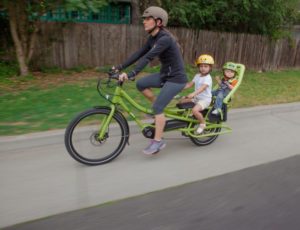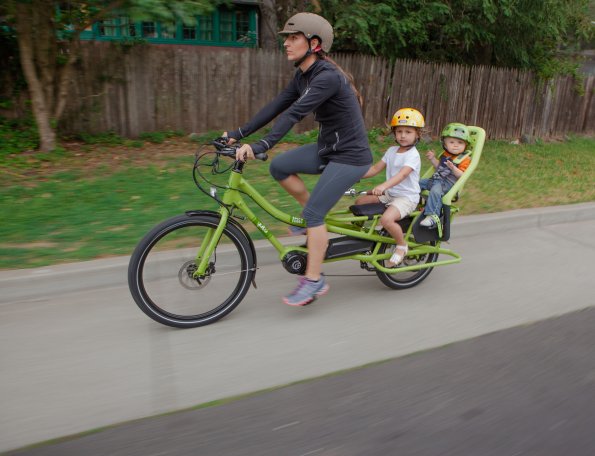Research Finds eBiking Replaces Car Trips
 By Richard Shrubb
By Richard Shrubb
A report for the Portland, OR based National Institute for Transportation and Communities (NITC) shows that e-bike users are increasingly replacing car use with e-bikes.
The research published last month found, “The majority of the utilitarian trips (i.e., errands and commutes) being made by e-bike are replacing motor vehicle trips, which signifies an impressive decrease in vehicle miles traveled.”
The research involved a survey of 1,759 e-bike users and owners across the United States, and it also found that people who might not use traditional bikes due to age and physical disability are using e-bikes, and that there is a perception of increased safety on e-bikes.
The Move From Cars To E-Bikes

John MacArthur from OTREC & PSU
John MacArthur was the lead author of the NITC report, and told the Electric Bike Report, “While many of the rides we surveyed were for recreation, on average we found that the average trip on an e-bike was nine miles,” adding, “historically on traditional bicycles we see a trip of more than five miles being a barrier.”
Before the advent of e-bikes people would have used their cars for trips of five miles and more, but the range seems to have been extended by 80% on e-bikes. In car mad America this is a significant finding.
MacArthur added that e-bike users expressly stated that they shifted from cars to e-bikes: “Mainly for those commuting or utilitarian trips, they were saying ‘I would have used my car for this trip if it wasn’t for my e-bike.’”

John MacArthur out for a ride.
Pull factors
There are incentives that move people across from their cars to e-bikes. Some come from within the person themselves – others come from without.
Core to this draw from the internal combustion engine to the freedom of riding on two wheels is pure enjoyment.
MacArthur pointed out, “People riding e-bikes can’t stop saying how much fun it is! It is evident through what they write and how they communicate how much fun and enjoyment they get out of riding their e-bikes.”
This isn’t an anomaly either – MacArthur has seen this particular draw from other research he has done and by other organizations around the world.
Another important factor is cycling infrastructure. If a city or state goes out of its way to invest in safe and high-quality cycling infrastructure to tackle congestion and pollution, it is evident that people will use it.
“There will be pockets where a mode shift [from cars to bicycles] happens more dramatically and quickly in cities that are investing in bicycle infrastructure such as Portland, a bunch of Californian cities and even places like Chicago and Minneapolis,” explained MacArthur.
While there may have been a modal shift of some kind before e-bikes came along, the added power and range that come from them seems to be accelerating and deepening that shift.

Portland’s car free Tilikum Crossing bridge.
MacArthur suggested, “Portland has one of the highest bicycle commuting rates of any city in the US at about 7%. We are hoping that goes up to 15% in the next 10 years. Without e-biking we will not achieve that.”
Safety is important too. The NITC paper showed that a pull factor of people moving from cars to e-bikes is a perception of safety of e-bikes over traditional bikes.
No studies have shown empirically whether e-bikes are safer than bicycles though, according to the report, “Respondents were approximately eight times more likely to report that their e-bike has helped them avoid a crash than they were to report that their e-bike has significantly contributed to a crash”.
This perception of safety is put down to the speed, range and agility that comes from e-bike riding: ”With the help of the electric assist, e-bike users can take longer routes to avoid utilizing dangerous streets, they can accelerate quickly to get through wide intersections or away from a potential conflict, and they are able to keep up with the pace of traffic which minimizes the speed differential.”
Breaking America’s Car Habit
The US is famous for having a ‘car addiction’ due in part to the longer distances people have to travel to get anywhere – it is a big country on a large continent.
Modal shift will not be as easy as it might in a small, densely populated country such as the United Kingdom or other European countries.

Car? What car?
Where people do live in more densely populated areas such as Portland, San Francisco or Chicago, then there will be a faster and greater shift from cars to bikes and e-bikes, simply because of the shorter relative distances people have to travel to get between the places they would frequent.
If your commute is an easy nine miles by e-bike and you can travel faster than by car then it makes sense to go on two wheels, perhaps more than should you have to travel 20 miles for a similar journey.
There are nearly 300 million US citizens and a survey of 2,000 e-bike users isn’t a huge proportion of that. Nevertheless as e-bike sales get traction across the country, there could well be signs that people choose to use their e-bikes over cars simply because it is a fun and accessible way to get about.
You don’t have to ‘believe in climate change’ to get a kick out of e-biking and therefore to get out of your car and onto two wheels for the sheer fun of it!
-By Richard Shrubb
P.S. Don’t forget to join the Electric Bike Report community for updates from the electric bike world, plus ebike riding and maintenance tips!
Reader Interactions
Trackbacks
-
-
[…] early 2018 Electric Bike Report showed the results of a study conducted by the National Institute for Transportation and Communities […]



[…] EBR has recently reported that “a report for the Portland, OR based National Institute for Transportation and Communities (NITC) shows that e-bike users are increasingly replacing car use with e-bikes.” For the full article see here. […]